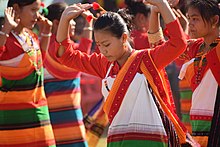திமாசா மக்கள்
திமாசா மக்கள் (Dimasa people), இந்தியாவின் அசாம் மற்றும் நாகலாந்து மாநிலங்களில் வாழும் பழங்குடி மக்கள் ஆவார். இம்மக்கள் திபெத்திய-பர்மிய மொழக் குடும்பத்தைச் சேர்ந்த திமாசா மொழியை பேசுகின்றனர். 2011-ஆம் ஆண்டின் மக்கள் தொகை கணக்கெடுப்பின்படி, இம்மக்கள் தொகை 2,62,413 ஆகும். இம்மக்கள் இந்து சமயத்தை மட்டும் பின்பற்றுகின்றனர்.
| திமாசா | |
|---|---|
 பாரம்பரிய நடனம் ஆடும் திமாசா பெண்கள் | |
| மொத்த மக்கள்தொகை | |
| 262,413 (2011 கணக்கெடுப்பு) | |
| குறிப்பிடத்தக்க மக்கள்தொகை கொண்ட பகுதிகள் | |
| 142,961 (2011, அசாமின் மலை மாவட்டங்களில் மட்டும்)[1] | |
| மொழி(கள்) | |
| திமாசா மொழி, அசாமிய மொழி | |
| சமயங்கள் | |
| இந்து சமயம் | |
காமரூப பேரரசு கிபி 1140-இல் வீழ்ச்சி அடைந்த போது, திமாசா மக்கள் 13-ஆம் நூற்றாண்டில் திமாசா இராச்சியத்தை நிறுவினர். இந்த இராச்சியம் 1832ல் பிரித்தானிய இந்தியாவின் ஆட்சியாளர்களால் கைப்பற்றப்பட்டது.
அசாம் மாநிலத்தின் கிழக்கில் உள்ள திமா ஹசாவ் மாவட்டம், கிழக்கு கர்பி அங்லோங் மாவட்டம், மேற்கு கர்பி அங்லோங் மாவட்டம், நகாமோ மாவட்டம், ஹொஜாய் மாவட்டம், கசார் மாவட்டம் மற்றும் நாகாலாந்து மாநிலத்தின் திமாப்பூர் மாவட்டத்தில் அதிகம் வாழம் திமாசா மக்களின் முக்கியத் தொழில் வேளாண்மை ஆகும்.
இதனையும் காண்க
தொகுஅடிக்குறிப்புகள்
தொகு- ↑ "ST-14 Scheduled Tribe Population By Religious Community - Assam". census.gov.in. பார்க்கப்பட்ட நாள் 29 February 2020.
மேற்கோள்கள்
தொகு- வார்ப்புரு:Wikicite
- Jacquesson, François (2008). "Discovering Boro-Garo". History of an Analytical and Descriptive Linguistic Category. http://himalaya.socanth.cam.ac.uk/collections/journals/ebhr/pdf/EBHR_32_02.pdf.
- Bareh, H. Gazetteer of India
- Barman, N. K. Queen of Cachar of Herambo and the History of the Kachchhari
- Barpujari, S. K. (ed) (1997) History of the Dimasas: from the earliest times to 1896 AD, Haflong: Autonomous Council, N.C. Hills District (Assam) .
- Bathari, Uttam (2014). Memory History and polity a study of dimasa identity in colonial past and post colonial present (PhD). Gauhati University. hdl:10603/115353.
- Bhattacharjee, J. B. (1992), "The Kachari (Dimasa) state formation", in Barpujari, H. K. (ed.), The Comprehensive History of Assam, vol. 2, Guwahati: Assam Publication Board, pp. 391–397
- Bordoloi, B. N. (1988) The Dimasa Kachari, Tribal Research Institute of Assam, Guwahati.
- Danda, D. (1989) The Dimasa Kacharis of Assam, Concept Publishing co. New Delhi.
- Gait, Edward A. (1906) A History of Assam, Calcutta 1906.
- Rhodes, N. G. and Bose, S. K. (2006) A History of the Dimasa Kacharis - As Seen through Coinage New Delhi : Mira Basu Publishers.
- Roy, Babul (1998) "Socio-Cultural and Environmental Dimensions of Tribal Health: A Study among the Dimasa Kacharis and the Zeme Nagas of N. C. Hills in Assam" Ph. D. Thesis (Unpublished), Gauhati University, Guwahati, Assam (India).
- Roy, Babul (2000) "Medical Pluralism and Pattern of Acceptance of Medicine among the Dimasa Kacharis of Assam" The Journal of Human Ecology. Kamal-Raj Pub., Delhi.
- Roy, Babul (2002) "Descent groupings, belief system and social structure among the Dimasa Kacharies of Assam", Man in India, Vol.82,No.1&2.
- Ramirez, Ramirez (2007), "Politico-ritual variations on the Assamese fringes: Do social systems exist?", in Sadan, Mandy; Robinne., François (eds.), Social Dynamics in the Highlands of Southeast Asia Reconsidering Political Systems of Highland Burma, Boston: Brill, pp. 91–107
- Shin, Jae-Eun (2020). "Descending from demons, ascending to kshatriyas: Genealogical claims and political process in pre-modern Northeast India, The Chutiyas and the Dimasas". The Indian Economic and Social History Review 57 (1): 49–75. doi:10.1177/0019464619894134.